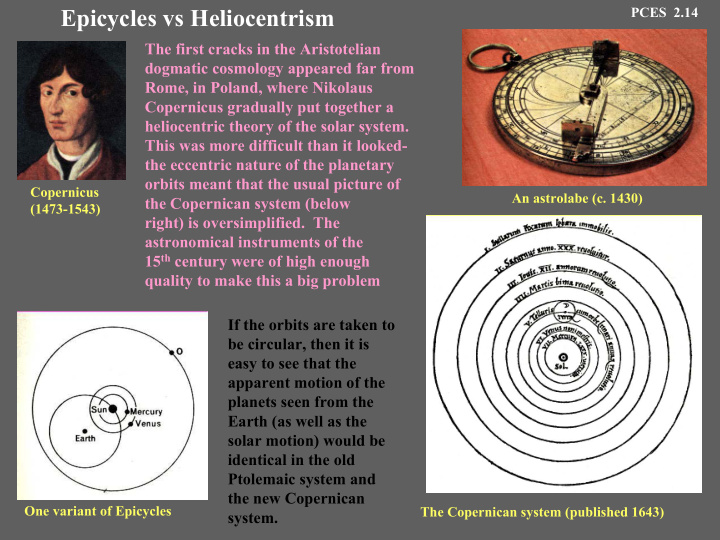



Epicycles vs Heliocentrism PCES 2.14 The first cracks in the Aristotelian dogmatic cosmology appeared far from Rome, in Poland, where Nikolaus Copernicus gradually put together a heliocentric theory of the solar system. This was more difficult than it looked- the eccentric nature of the planetary orbits meant that the usual picture of Copernicus An astrolabe (c. 1430) the Copernican system (below (1473-1543) right) is oversimplified. The astronomical instruments of the 15 th century were of high enough quality to make this a big problem If the orbits are taken to be circular, then it is easy to see that the apparent motion of the planets seen from the Earth (as well as the solar motion) would be identical in the old Ptolemaic system and the new Copernican One variant of Epicycles The Copernican system (published 1643) system.
PCES 2.15 Tycho Brahe & Uraniborg The ideas of Copernicus were slow to catch on. Curiously, one of the principal architects of the changing views was strongly opposed to them. Tycho Brahe was a remarkable pioneer in Tycho Brahe observational astronomy, whose opinions now (1546-1601) seem a bizarre mix to us- he believed that events were determined by the stars and the motion of the planets relative to them (ie., in astrology), but he was shaken by the appearance in 1572 of a new very bright star in the sky- this Supernova in Cassiopeia (1572) contradicted Aristotelian dogma about the immutability of the stars (and Tycho exploded the prevailing opinion that the star was a comet by careful observation). Soon thereafter the King of Denmark gave Tycho his own island to build the observatory of Uraniborg, & over the next few decades he developed instruments to record the motions of the moon, comets, & planets more accurately than ever before. On his death bed he begged Kepler not to use these against Plan of Uraniborg estate Tycho’s 2 metre sextant Aristotle’s system.
PCES 2.16 J. Kepler (I) Kepler was an assistant to Tycho, who spent years analysing the data he had amassed at Uraniborg. He concentrated on trying to understand the orbit of Mars, albeit with an initial belief in a variant of Eudoxus celestial spheres, which he tried to fit between solid geometrical shapes. It is J. Kepler (1571-1630) probably fortunate this was such a bad idea, and that he chose Mars, which has a rather eccentric orbit. Hundreds of pages of mathematical analysis led him slowly but inexorably to a picture which he eventually summarized in the form of his 3 laws (next page). He also wrote the 1 st science fiction novel (below left) and set the planetary motions to music)
PCES 2.17 J. Kepler (II) With great creative insight Kepler realised that he could understand the planetary motions to very high accuracy by starting from 3 hypotheses, which came to be known as Kepler’s 3 Laws: (1) Each planet moves around the sun in an elliptical orbit, with the sun at one of the foci. (2) The radius vector of the orbit (from the sun to the planet) sweeps out equal areas in equal times- as shown in the figure. (3) If T is the orbital period of a planet, and a is the length of the semi-major axis (ie., half the length of the ‘long diameter’), then T ~ a 3/2 ie., T 2 ~ a 3 , or, to put it in words, the square of the orbital time period increases in proportion to the cube of the size of the orbit. These laws were not completely accurate but they were FAR more accurate than anything before- with his combination of mysticism and respect for the astronomical facts, Kepler had broken the Aristotelian mold. However he had no EXPLANATION for his laws- they were just a way of understanding the data.
Recommend
More recommend